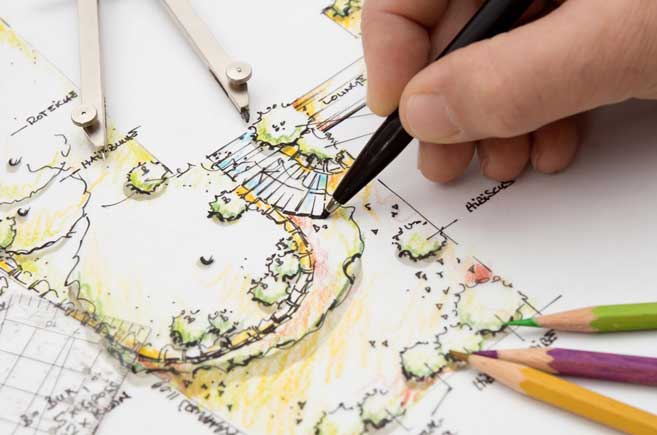Blueprints Gone Green
It took me 12 months of being reminded by the sign hanging on the entrance of the Outpost Co-op grocery store in Bay View before I finally step through the doors with my reusable bag in hand, head held high. It feels good to be green.
Only on this particular day, I’m at the new Mequon location to see what all the fuss is about. News reports, press releases, newsletters—all touting the store’s groundbreaking “green” design.
The parking lot is packed. I managed to snag a spot next the Ford Fusion Energi Hybrid plugged into the car charging station. Inside the sun shines bright through the skylights as I notice the customer recycling station tucked to the right of the second entrance.
Everything from cell phones to wine corks to plastic bags can be guiltlessly disposed of—even the recycling bins themselves are made locally from 99% plastic recycled milk containers. In 2013, the effort to install these stations at all four locations came shortly after the hiring of Sustainability Manager Jessy Servi. It’s a newly created job title that reiterates Outpost’s mission to create a healthy, diverse and sustainable community. And it’s built to last.
Throughout the store green features range on a spectrum from the obvious use of natural light and LED lighting to the more obscure repurposing of resources. Customers don’t notice heat being recouped from the refrigeration units as they peruse the aisles for locally-sourced produce, organic wines, and artisan goods. Beneath the recycled rubber and polished concrete floors are underground containers storing captured rainwater. Up above, the roof is built to hold future solar panels. In the café, reclaimed materials from the pre-existing home on-site make up the décor on the wall.
The opening of the new store was meant to meet a noticeable demand from customers making the commute south from Mequon to Milwaukee, says Servi. But it’s come to epitomize practices that tread lightly on the land and progress toward more symbiotic relationships with the environment. “Making buildings sustainable is really site specific and takes a lot of factors into account,” says Servi. “Sun, water, weather patterns and using materials that are safe, chemical-free, and ideally recycled or reclaimed is so important.”
LEEDing the Way
The Mequon design is on its way to receiving a Gold certification in LEED, short for the internationally-renowned Energy & Environment Design… and it’s kind of a big deal.
LEED works like a rating system, offering points for meeting designated pre-requisites. One point for bicycle facilities, two points for enhanced indoor air quality, three points for rainwater management, etc. How many points the business “earns” determines the level of certification received. Of the four possible levels—from lowest to highest: Certified, Silver, Gold and Platinum—going for Gold requires an accumulation of between 60 and 79 points.
Almost every feature on the grounds has a specific and sustainably designed function, even the perennials that make up a majority of the landscape. A grant from the Milwaukee Metropolitan Sewerage District helped fund the property’s rain gardens, which are filled with hundreds of carefully selected plants. They’re used to capture storm water that’s drained into an underground water recycling system, where roof rainwater catchment is also stored in cisterns to be used for property maintenance. The exact number of plants along with their tolerance for various conditions is all spelled out in Servi’s annual Sustainability Report, a 46-page document that tracks Outpost’s shrinking carbon footprints.
The report is submitted to the Sustainable Food Trade Association (SFTA) and thoroughly discloses Outpost’s green undertakings, along with the short- and long-term status of current goals. If you’re curious about what percentage of their sales comes from locally-sourced goods or from organic dairy, the answers are only a click away. The coop posts a link to the document on their website (outpost.coop). “As you can see, we don’t always reach our goals,” says Servi, “but we believe in being as transparent as possible with what we’re trying to achieve. Monitoring this data helps us set attainable objectives and make appropriate decisions to get there.”
In 2013, the co-op created a local purchasing specialist position, filled by a former assistant store manager, to increase the availability of goods from local vendors. Only it’s not as simple as just buying more products within a given radius. How items are packaged, produced and certified all weigh into the purchasing decisions.
The G-Team
Job descriptions that focus on improving sustainable metrics data are not as scarce as you might think. Whole Foods, for example, appointed a Green Mission Leadership Team, which includes the Global Leader of Sustainable Engineering, Maintenance & Energy Management along with several regional Green Mission Specialists. On the ground level, individual stores have self-managed Green Mission task forces to work on environmental initiatives that advocate for greener packaging, energy reduction, and waste diversion campaigns. Their allegiance to such causes in pronounced in the company’s track record for being the first major retailer to offset 100 percent of their energy use with wind energy credits.
Following suit, Servi developed a framework for a similar green task force program for Outpost. “Each store has their own Green Team with a representative from every department,” says Servi. “It’s a cross-functional approach and lets individual stores determine their own priorities,” with the primary issue almost always being waste. “It’s really become a multi-tiered strategy to what we sometimes refer to as Project Waste,” Servi laughs, realizing how unsexy it sounds. But here’s a hot statistic: In 2013, the co-op diverted more than 16 tons of waste from the landfill and recycled 32 tons of materials, not including the 275 tons of recycled cardboard or 2.4 tons of soft plastic. With numbers like that, the grass is looking a little greener for everyone.
The Green House Effect
As the green building movement gains momentum, so does the consumer demand for greener properties, points out real estate specialist Toni Spott, a National Association of Realtors (NARS) Green Designee. Spott completed the necessary coursework to join a small but growing network of green realtors to help her Milwaukee-area clients seek out homes with energy-efficient appliances and healthy indoor air quality.
“It’s interesting, studies show two-thirds of consumers are paying attention to green homes and buildings,” Spott says, “but there aren’t a lot of green properties to sell in SE Wisconsin… There are some apartments on the East side, but right now that’s about it.”
The properties she’s referring to include the Mandel Group’s North End apartment homes on the east bank of the Milwaukee River. Each unit is equipped with high efficiency air systems and energy star appliances. A green roof space designed to absorb heat and water—an amenity that both reduces energy costs and lowers the burden of water runoff in the city’s sewer system—tops the complex. It’s one of three green roof projects in the group’s portfolio, and a fourth is in the works.
Developers with an eco-friendly mission have a responsibility to the environment that involves the lifespan and renewability of resources, even though these practices often go unnoticed by consumers.
“We look to partner with local manufacturers for building products that we incorporate into our developments,” says Robert Monnat, Chief Operating Officer and Partner of the Mandel Group. Hardwood floors, for instance, are harvested and milled in Wisconsin, where four trees are re-planted for every one that is cut. Fixtures for their new developments are purchased locally from Kohler, Master Lock, and others. “In this small way we recycle the dollars we invest in our local economy and help to grow Milwaukee,” he says.
“It’s not just a fad,” adds Spott. “Green real estate is altering market dynamics; sustainable properties are the future of the real estate industry.”







